Ido Hakimi
Department of Computer Science, Technion
Learning on the Job: Test-Time Curricula for Targeted Reinforcement Learning
Oct 06, 2025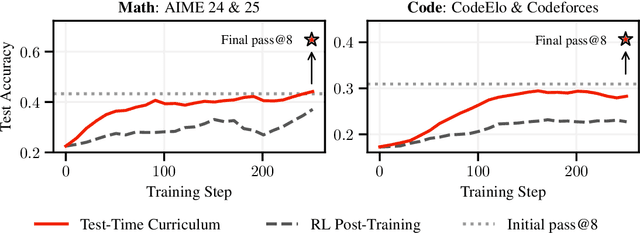
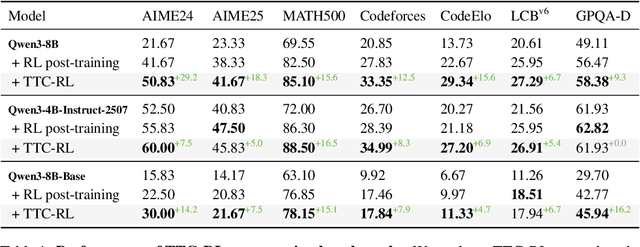
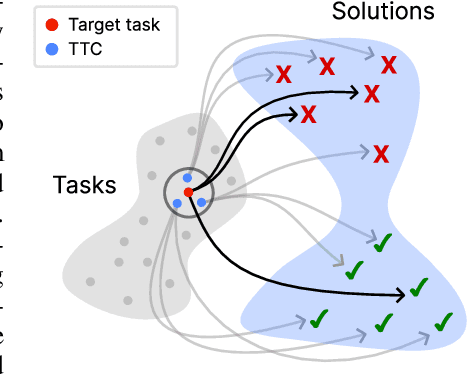
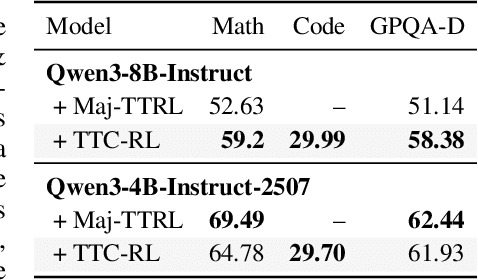
Abstract:Humans are good at learning on the job: We learn how to solve the tasks we face as we go along. Can a model do the same? We propose an agent that assembles a task-specific curriculum, called test-time curriculum (TTC-RL), and applies reinforcement learning to continue training the model for its target task. The test-time curriculum avoids time-consuming human curation of datasets by automatically selecting the most task-relevant data from a large pool of available training data. Our experiments demonstrate that reinforcement learning on a test-time curriculum consistently improves the model on its target tasks, across a variety of evaluations and models. Notably, on challenging math and coding benchmarks, TTC-RL improves the pass@1 of Qwen3-8B by approximately 1.8x on AIME25 and 2.1x on CodeElo. Moreover, we find that TTC-RL significantly raises the performance ceiling compared to the initial model, increasing pass@8 on AIME25 from 40% to 62% and on CodeElo from 28% to 43%. Our findings show the potential of test-time curricula in extending the test-time scaling paradigm to continual training on thousands of task-relevant experiences during test-time.
Apertus: Democratizing Open and Compliant LLMs for Global Language Environments
Sep 17, 2025



Abstract:We present Apertus, a fully open suite of large language models (LLMs) designed to address two systemic shortcomings in today's open model ecosystem: data compliance and multilingual representation. Unlike many prior models that release weights without reproducible data pipelines or regard for content-owner rights, Apertus models are pretrained exclusively on openly available data, retroactively respecting robots.txt exclusions and filtering for non-permissive, toxic, and personally identifiable content. To mitigate risks of memorization, we adopt the Goldfish objective during pretraining, strongly suppressing verbatim recall of data while retaining downstream task performance. The Apertus models also expand multilingual coverage, training on 15T tokens from over 1800 languages, with ~40% of pretraining data allocated to non-English content. Released at 8B and 70B scales, Apertus approaches state-of-the-art results among fully open models on multilingual benchmarks, rivalling or surpassing open-weight counterparts. Beyond model weights, we release all scientific artifacts from our development cycle with a permissive license, including data preparation scripts, checkpoints, evaluation suites, and training code, enabling transparent audit and extension.
From Problem-Solving to Teaching Problem-Solving: Aligning LLMs with Pedagogy using Reinforcement Learning
May 21, 2025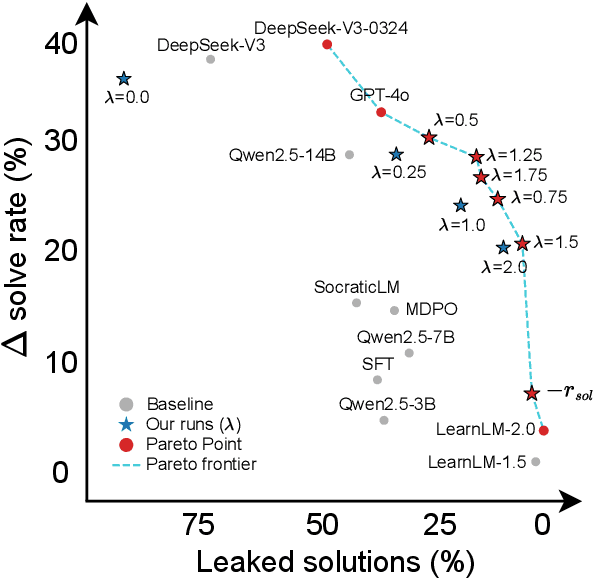
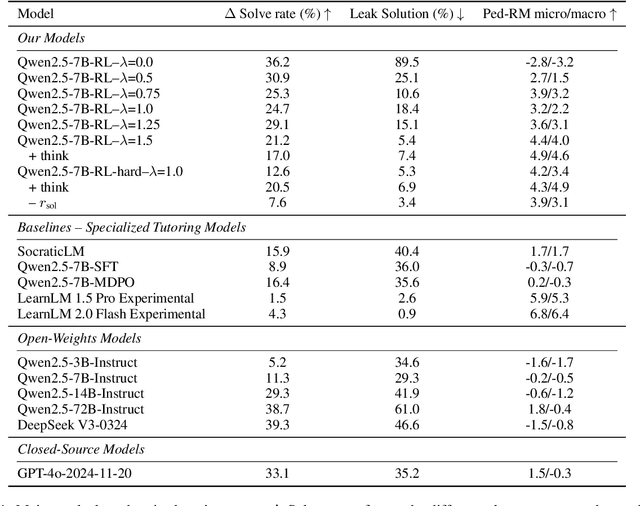
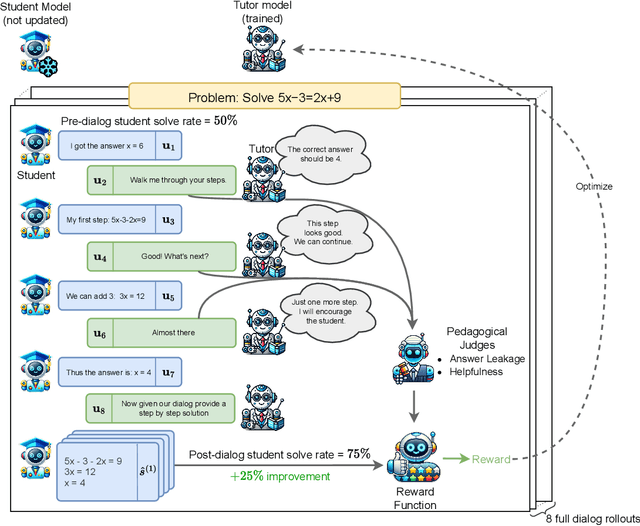

Abstract:Large language models (LLMs) can transform education, but their optimization for direct question-answering often undermines effective pedagogy which requires strategically withholding answers. To mitigate this, we propose an online reinforcement learning (RL)-based alignment framework that can quickly adapt LLMs into effective tutors using simulated student-tutor interactions by emphasizing pedagogical quality and guided problem-solving over simply giving away answers. We use our method to train a 7B parameter tutor model without human annotations which reaches similar performance to larger proprietary models like LearnLM. We introduce a controllable reward weighting to balance pedagogical support and student solving accuracy, allowing us to trace the Pareto frontier between these two objectives. Our models better preserve reasoning capabilities than single-turn SFT baselines and can optionally enhance interpretability through thinking tags that expose the model's instructional planning.
Local Mixtures of Experts: Essentially Free Test-Time Training via Model Merging
May 20, 2025Abstract:Mixture of expert (MoE) models are a promising approach to increasing model capacity without increasing inference cost, and are core components of many state-of-the-art language models. However, current MoE models typically use only few experts due to prohibitive training and inference cost. We propose Test-Time Model Merging (TTMM) which scales the MoE paradigm to an order of magnitude more experts and uses model merging to avoid almost any test-time overhead. We show that TTMM is an approximation of test-time training (TTT), which fine-tunes an expert model for each prediction task, i.e., prompt. TTT has recently been shown to significantly improve language models, but is computationally expensive. We find that performance of TTMM improves with more experts and approaches the performance of TTT. Moreover, we find that with a 1B parameter base model, TTMM is more than 100x faster than TTT at test-time by amortizing the cost of TTT at train-time. Thus, TTMM offers a promising cost-effective approach to scale test-time training.
MathTutorBench: A Benchmark for Measuring Open-ended Pedagogical Capabilities of LLM Tutors
Feb 26, 2025Abstract:Evaluating the pedagogical capabilities of AI-based tutoring models is critical for making guided progress in the field. Yet, we lack a reliable, easy-to-use, and simple-to-run evaluation that reflects the pedagogical abilities of models. To fill this gap, we present MathTutorBench, an open-source benchmark for holistic tutoring model evaluation. MathTutorBench contains a collection of datasets and metrics that broadly cover tutor abilities as defined by learning sciences research in dialog-based teaching. To score the pedagogical quality of open-ended teacher responses, we train a reward model and show it can discriminate expert from novice teacher responses with high accuracy. We evaluate a wide set of closed- and open-weight models on MathTutorBench and find that subject expertise, indicated by solving ability, does not immediately translate to good teaching. Rather, pedagogy and subject expertise appear to form a trade-off that is navigated by the degree of tutoring specialization of the model. Furthermore, tutoring appears to become more challenging in longer dialogs, where simpler questioning strategies begin to fail. We release the benchmark, code, and leaderboard openly to enable rapid benchmarking of future models.
Efficiently Learning at Test-Time: Active Fine-Tuning of LLMs
Oct 10, 2024Abstract:Recent efforts in fine-tuning language models often rely on automatic data selection, commonly using Nearest Neighbors retrieval from large datasets. However, we theoretically show that this approach tends to select redundant data, limiting its effectiveness or even hurting performance. To address this, we introduce SIFT, a data selection algorithm designed to reduce uncertainty about the model's response given a prompt, which unifies ideas from retrieval and active learning. Whereas Nearest Neighbor retrieval typically fails in the presence of information duplication, SIFT accounts for information duplication and optimizes the overall information gain of the selected examples. We focus our evaluations on fine-tuning at test-time for prompt-specific language modeling on the Pile dataset, and show that SIFT consistently outperforms Nearest Neighbor retrieval, with minimal computational overhead. Moreover, we show that our uncertainty estimates can predict the performance gain of test-time fine-tuning, and use this to develop an adaptive algorithm that invests test-time compute proportional to realized performance gains. We provide the $\texttt{activeft}$ (Active Fine-Tuning) library which can be used as a drop-in replacement for Nearest Neighbor retrieval.
q2d: Turning Questions into Dialogs to Teach Models How to Search
Apr 27, 2023Abstract:One of the exciting capabilities of recent language models for dialog is their ability to independently search for relevant information to ground a given dialog response. However, obtaining training data to teach models how to issue search queries is time and resource consuming. In this work, we propose q2d: an automatic data generation pipeline that generates information-seeking dialogs from questions. We prompt a large language model (PaLM) to create conversational versions of question answering datasets, and use it to improve query generation models that communicate with external search APIs to ground dialog responses. Unlike previous approaches which relied on human written dialogs with search queries, our method allows to automatically generate query-based grounded dialogs with better control and scale. Our experiments demonstrate that: (1) For query generation on the QReCC dataset, models trained on our synthetically-generated data achieve 90%--97% of the performance of models trained on the human-generated data; (2) We can successfully generate data for training dialog models in new domains without any existing dialog data as demonstrated on the multi-hop MuSiQue and Bamboogle QA datasets. (3) We perform a thorough analysis of the generated dialogs showing that humans find them of high quality and struggle to distinguish them from human-written dialogs.
Learning Under Delayed Feedback: Implicitly Adapting to Gradient Delays
Jun 23, 2021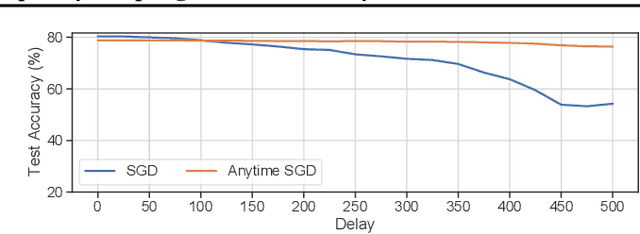

Abstract:We consider stochastic convex optimization problems, where several machines act asynchronously in parallel while sharing a common memory. We propose a robust training method for the constrained setting and derive non asymptotic convergence guarantees that do not depend on prior knowledge of update delays, objective smoothness, and gradient variance. Conversely, existing methods for this setting crucially rely on this prior knowledge, which render them unsuitable for essentially all shared-resources computational environments, such as clouds and data centers. Concretely, existing approaches are unable to accommodate changes in the delays which result from dynamic allocation of the machines, while our method implicitly adapts to such changes.
Gap Aware Mitigation of Gradient Staleness
Sep 25, 2019



Abstract:Cloud computing is becoming increasingly popular as a platform for distributed training of deep neural networks. Synchronous stochastic gradient descent (SSGD) suffers from substantial slowdowns due to stragglers if the environment is non-dedicated, as is common in cloud computing. Asynchronous SGD (ASGD) methods are immune to these slowdowns but are scarcely used due to gradient staleness, which encumbers the convergence process. Recent techniques have had limited success mitigating the gradient staleness when scaling up to many workers (computing nodes). In this paper we define the Gap as a measure of gradient staleness and propose Gap-Aware (GA), a novel asynchronous-distributed method that penalizes stale gradients linearly to the Gap and performs well even when scaling to large numbers of workers. Our evaluation on the CIFAR, ImageNet, and WikiText-103 datasets shows that GA outperforms the currently acceptable gradient penalization method, in final test accuracy. We also provide convergence rate proof for GA. Despite prior beliefs, we show that if GA is applied, momentum becomes beneficial in asynchronous environments, even when the number of workers scales up.
Taming Momentum in a Distributed Asynchronous Environment
Jul 26, 2019
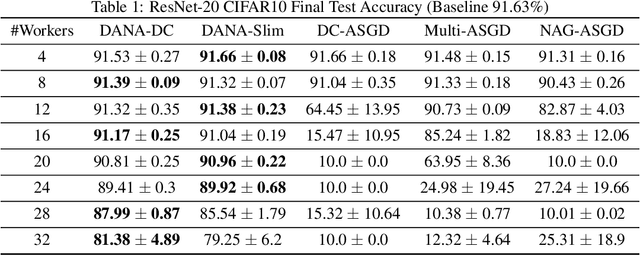

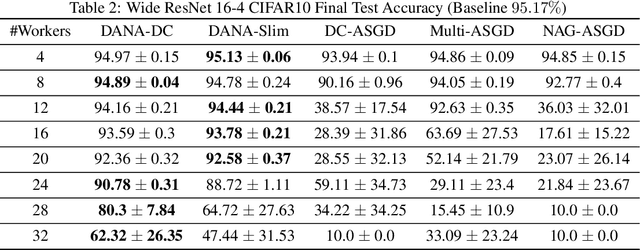
Abstract:Although distributed computing can significantly reduce the training time of deep neural networks, scaling the training process while maintaining high efficiency and final accuracy is challenging. Distributed asynchronous training enjoys near-linear speedup, but asynchrony causes gradient staleness, the main difficulty in scaling stochastic gradient descent to large clusters. Momentum, which is often used to accelerate convergence and escape local minima, exacerbates the gradient staleness, thereby hindering convergence. We propose DANA: a novel asynchronous distributed technique which is based on a new gradient staleness measure that we call the gap. By minimizing the gap, DANA mitigates the gradient staleness, despite using momentum, and therefore scales to large clusters while maintaining high final accuracy and fast convergence. DANA adapts Nesterov's Accelerated Gradient to a distributed setting, computing the gradient on an estimated future position of the model's parameters. In turn, we show that DANA's estimation of the future position amplifies the use of a Taylor expansion, which relies on a fast Hessian approximation, making it much more effective and accurate. Our evaluation on the CIFAR and ImageNet datasets shows that DANA outperforms existing methods, in both final accuracy and convergence speed.
 Add to Chrome
Add to Chrome Add to Firefox
Add to Firefox Add to Edge
Add to Edge